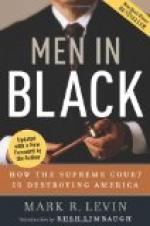The modern court-room is only an adapted continuation of a medieval idea. On the raised dais under an unsanitary and dusty canopy of green plush sits the judge; instead of a sceptre he holds the gavel. This gavel, by the way, is falling more and more into disuse. As a symbol of authority, a little wooden hammer has become a trifle ludicrous. If a judge were to shake it too violently there might be a fear on the part of those watching that he was about to throw it at the spectators or at one of the arguing lawyers.
The judge sits at an imposing high-railed desk with standard lights at either corner. The top of the desk is usually above the level of the eyes even of the lawyer standing. This is an arrangement which is conventional and convenient; it would not be consistent with the majesty of the law if the judge should be discovered writing a personal note or taking a glance at the stock market reports in the evening paper.
The judge’s chair is ordinarily a revolving one with a dip backward. Stationary chairs are trying, for those who have to remain quiet for so many hours at a time, and the swinging back and forth and twisting about gives a little relaxation.
In front of the judge’s dais are the counselors’ or lawyers’ tables, and at one side in front and below usually another table for reporters. It is somewhat like the arrangement in baronial halls where there was an upper and lower table and some sat below the salt and others above.
On one side, opposite, but not as high, is the jury-box. This is a pen with twelve seats within a high-sided inclosure like an old-fashioned pew. What the object of the inclosure may be is uncertain, unless it is a relic of a time when it was necessary to imprison the jurors. Jury duty has doubtless always been arduous and disagreeable, and in earlier days men were probably as anxious to escape serving on the jury as they are to-day. In one of the courts, which was not supposed to be for jury trials, twelve men once sat on a case without any jury-box in plain chairs and at the side of the room. They were extremely uncomfortable themselves; their legs were exposed and they seemed shockingly unconventional.
Between the judge’s desk and the jury-box is the witness chair, an ordinary chair placed not quite so high, but beside the judge’s and where he can look down on the witness. The position of the witness chair may be accountable for the feeling of protecting the witness that exists in the minds of the judge and jury. There is a natural sympathy for him, as though he were being attacked by the examining counsel. The witness in former times stood in a little enclosed box and in Italy, where court scenes are more intense, the prisoners to this day in criminal trials testify from behind iron bars.




